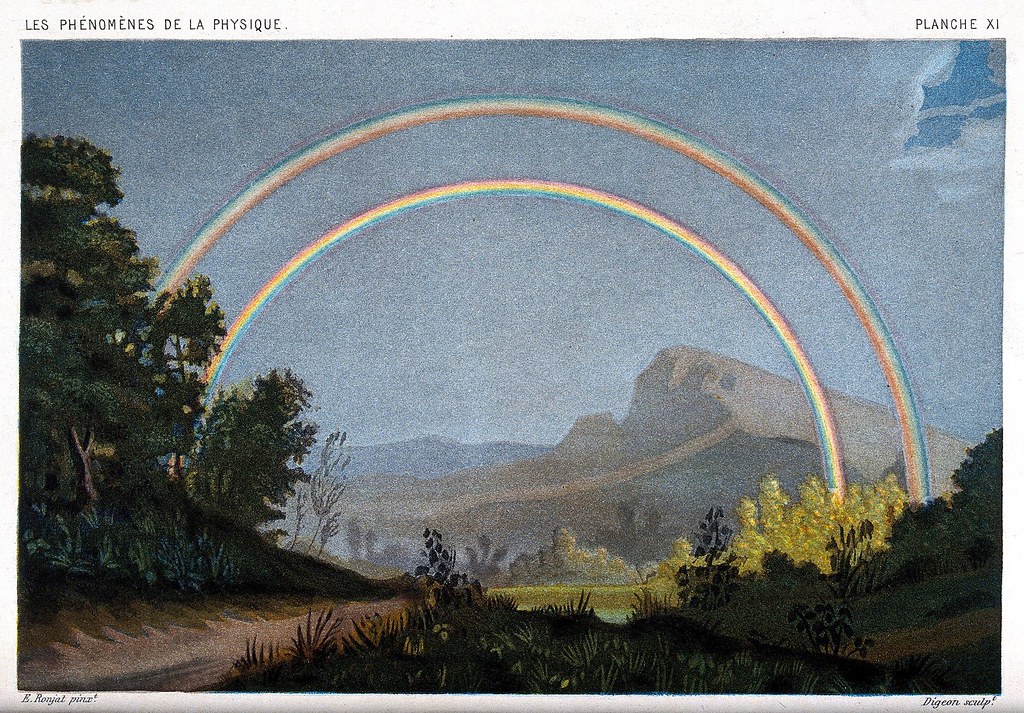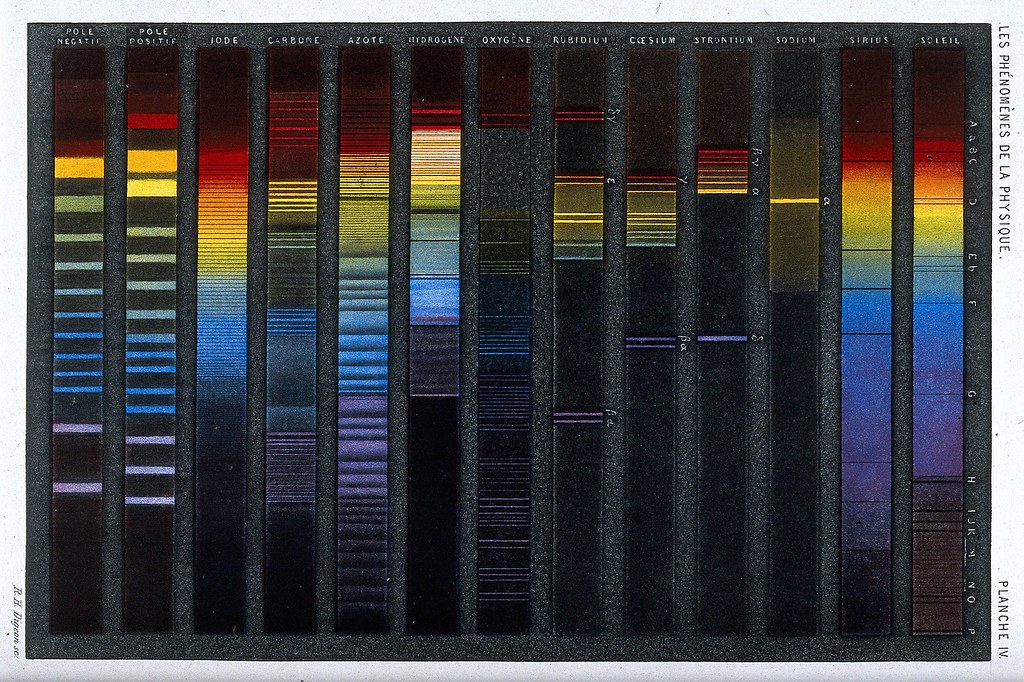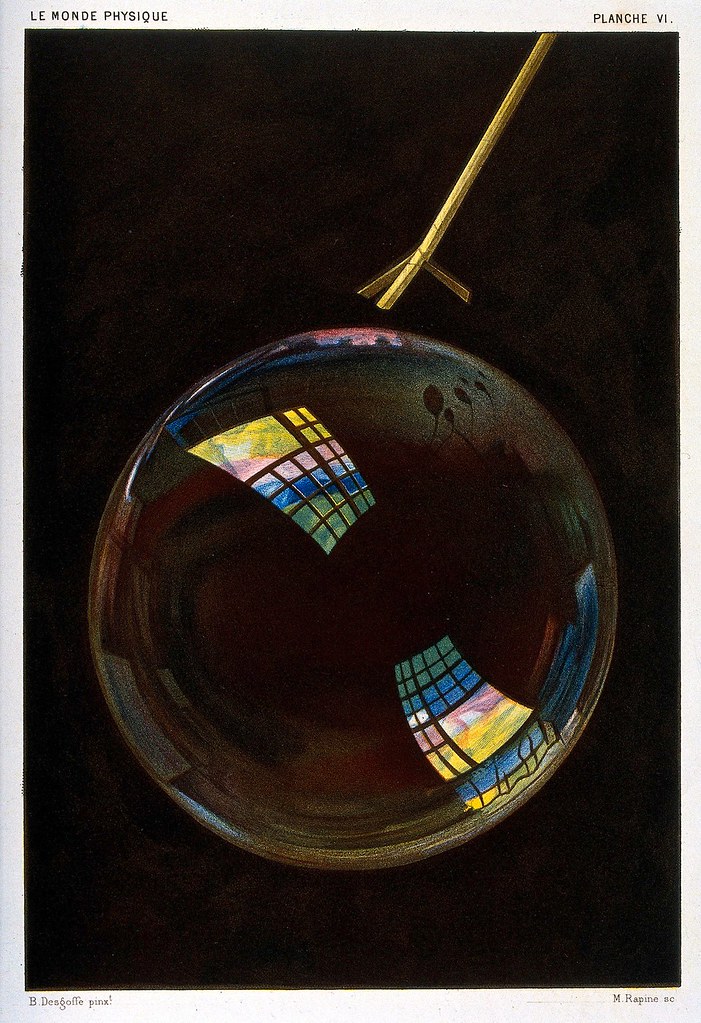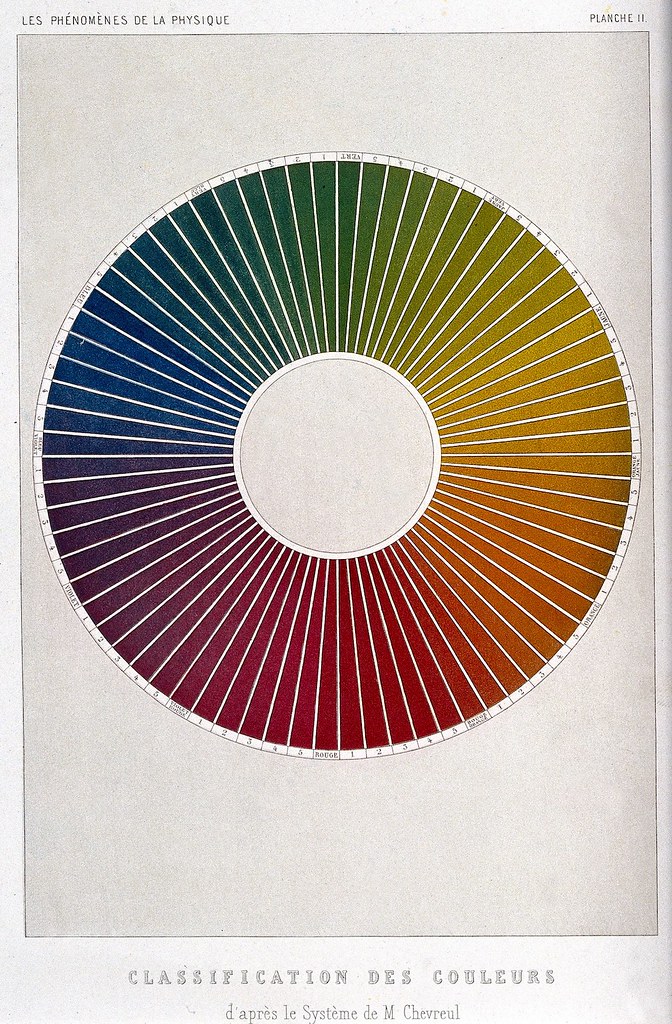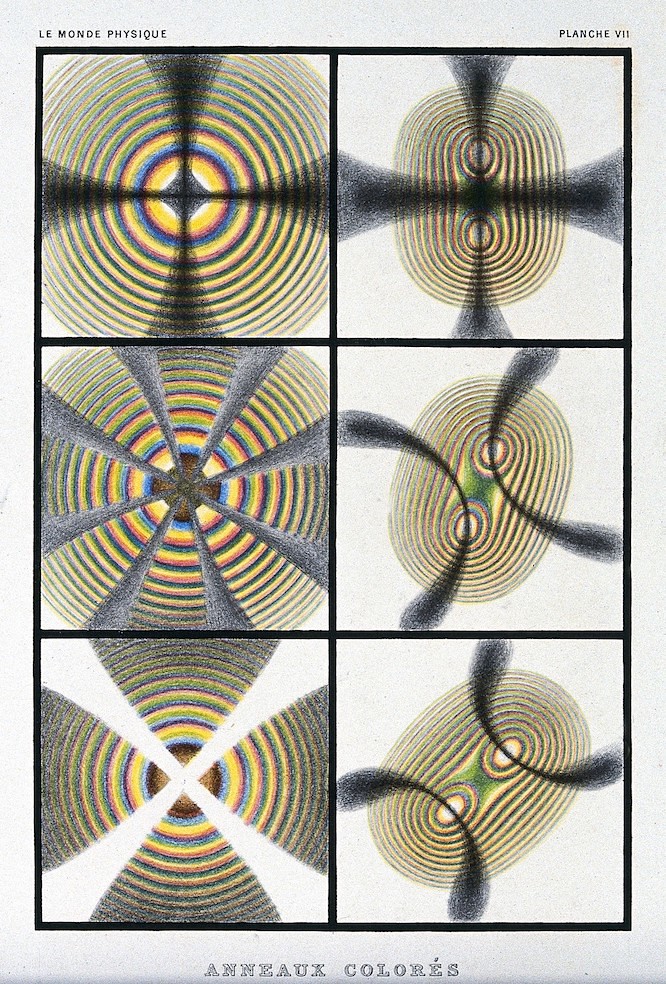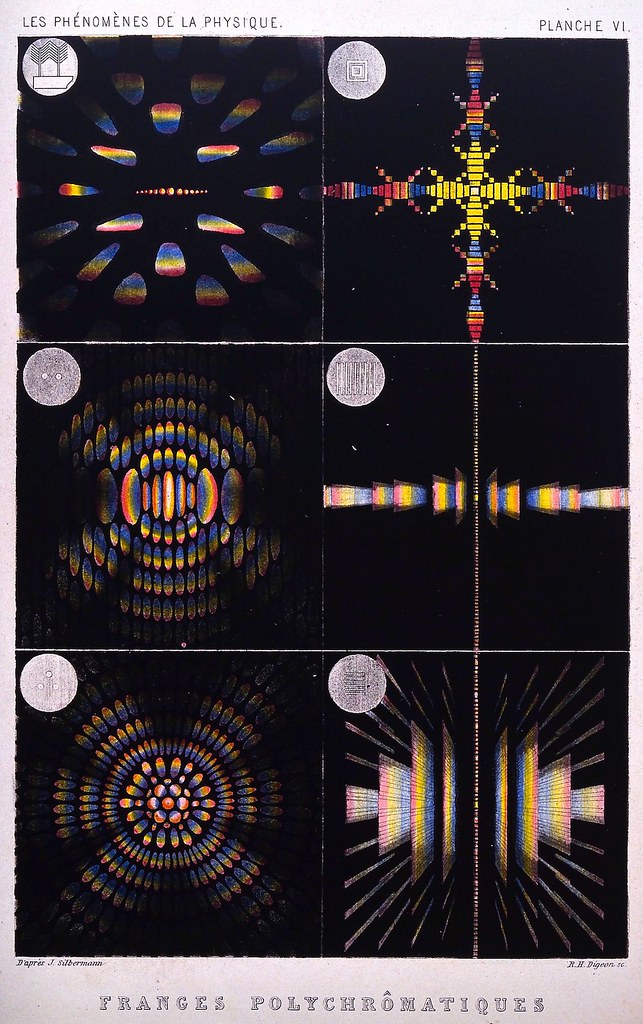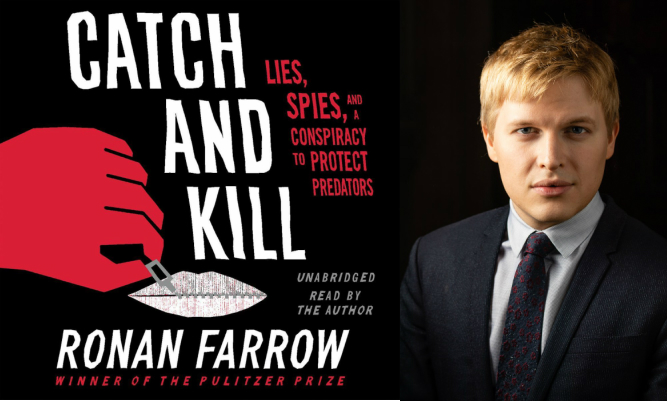[Most Recent Entries] [Calendar View]
Thursday, December 19th, 2019
| Time | Event |
| 9:00a | The Phenomena of Physics Illustrated with Psychedelic Art in an Influential 19th-Century Textbook
The science of optics and the fine art of science illustration arose together in Europe, from the early black-and-white color wheel drawn by Isaac Newton in 1704 to the brilliantly hand-colored charts and diagrams of Goethe in 1810. Goethe’s illustrations are more renowned than Newton’s, but both inspired a considerable number of scientific artists in the 19th century. It would take a science writer, the French journalist and mathematician Amédée Guillemin, to fully grasp the potential of illustration as a means of conveying the mind-bending properties of light and color to the general public. Guillemin published the hugely popular textbook Les phénomènes de la physique in 1868, eventually expanding it into a five-volume physics encyclopedia. (View and download a scanned copy at the Wellcome Collection.) He realized that in order to make abstract theories “comprehensible” to lay readers, Maria Popova writes at Brain Pickings, “he had to make their elegant abstract mathematics tangible and captivating for the eye. He had to make physics beautiful.” Guillemin commissioned artists to make 31 colored lithographs, 80 black-and-white plates, and 2,012 illustrated diagrams of the physical phenomena he described.
The most “psychedelic-looking illustrations,” notes the Public Domain Review, are by Parisian intaglio printer and engraver René Henri Digeon and “based on images made by the physicist J. Silbermann showing how light waves look when they pass through various objects, ranging from a bird’s feather to crystals mounted and turned in tourmaline tongs.” Digeon also illustrated the “spectra of various light sources, solar, stellar, metallic, gaseous, electric,” above, and created a color wheel, further down, based on a classification system of French chemist Michel Eugène Chevreul.
Many of Digeon’s images “were used to explain the phenomenon of birefringence, or double refraction,” the Public Domain Review writes (hence the double rainbow). In addition to his striking plates, this section of the book also includes the image of the soap bubble above, by artist M. Rapine, based on a painting by Alexandre-Blaise Desgoffe.
In turn, Guillemin’s lavishly illustrated encyclopedia continues to influence scientific illustrations of light and color spectra. “In order thus to place itself in communion with Nature,” he wrote, “our intelligence draws from two springs, both bright and pure, and equally fruitful—Art and Science.” See more art from the book at Brain Pickings and the Public Domain Review.
Related Content: The Vibrant Color Wheels Designed by Goethe, Newton & Other Theorists of Color (1665-1810) A 900-Page Pre-Pantone Guide to Color from 1692: A Complete Digital Scan Josh Jones is a writer and musician based in Durham, NC. Follow him at @jdmagness The Phenomena of Physics Illustrated with Psychedelic Art in an Influential 19th-Century Textbook is a post from: Open Culture. Follow us on Facebook, Twitter, and Google Plus, or get our Daily Email. And don't miss our big collections of Free Online Courses, Free Online Movies, Free eBooks, Free Audio Books, Free Foreign Language Lessons, and MOOCs. |
| 3:00p | Ronan Farrow’s Catch and Kill Podcast: Stream a Gripping ‘Audio Companion’ to His Bestselling Book
In late 2017, Ronan Farrow was on the verge of blowing open the story revealing the Harvey Weinstein sexual abuse allegations. But then executives at NBC News killed the story, Farrow claims. Bewildered, he took his reporting to the New Yorker, which then vetted and published his reporting. Fast forward two years, Farrow has won a Pulitzer and Harvey Weinstein is now using a walker and getting ready to go on trial. In his 2019 bestselling book, Catch and Kill: Lies, Spies, and a Conspiracy to Protect Predators, Farrow delves into "the systems that protect powerful men accused of terrible crimes in Hollywood, Washington, and beyond." That system includes media executives, tabloids, high-priced lawyers, undercover operatives, private intelligence agencies, and even, it appears, officials within our own legal system. A complement to his book, Farrow has now produced The Catch and Kill podcast, whose first episodes you can now stream online. Find it on Apple, Spotify, Stitcher, and other platforms. You can stream the first three episodes below. Episode 1: The Spy Episode 2: The Producer Episode 3: The Wire Ronan Farrow’s Catch and Kill Podcast: Stream a Gripping ‘Audio Companion’ to His Bestselling Book is a post from: Open Culture. Follow us on Facebook, Twitter, and Google Plus, or get our Daily Email. And don't miss our big collections of Free Online Courses, Free Online Movies, Free eBooks, Free Audio Books, Free Foreign Language Lessons, and MOOCs. |
| 8:00p | The Zen of Bill Murray: I Want to Be “Really Here, Really in It, Really Alive in the Moment” We all know, on the deepest level, what we have the potential to achieve; once in a great while, we even catch glimpses of just what we could do if only we put our minds to it. But what, if anything, does it mean to "put our minds to it"? In breaking down that cliché, we might look to the example of Bill Murray, an actor for whom breaking down clichés has become a method of not just working but living. In the 2015 Charlie Rose clip above, Murray tells of receiving a late-night phone call from a friend's drunken sister. "You have no idea how much you could do, Bill, if you could just — you can do so much," the woman kept insisting. But to the still more or less asleep Murray, her voice sounded like that of "a visionary speaking to you in the night and coming to you in your dream." Through her inebriation, this woman spoke directly to a persistent desire of Murray's, one he describes when Rose asks him "what it is that you want that you don't have." Murray replies that he'd "like to be more consistently here," that he'd like to "see how long I can last as being really here — you know, really in it, really alive in the moment." He'd like to see what he could do if he could stay off human auto-pilot, if he "were able to not get distracted, to not change channels in my mind and body, so I would just, you know, be my own channel." He grounds this potentially spiritual-sounding idea in physical terms: "It is all contained in your body, everything you've got: your mind, your spirit, your soul, your emotions, it is all contained in your body. All the prospects, all the chances you ever have." Murray had spoken in even more detail of the body's importance at the previous year's Toronto International Film Festival. "How much do you weigh?" he asked his audience there, leading them into an impromptu guided meditation. "Try to feel that weight in your seat right now, in your bottom right now." If you can "feel that weight in your body, if you can come back into the most personal identification, a very personal identification, which is: I am. This is me now. Here I am, right now. This is me now." The idea is to be here now, to borrow the words with which countercultural icon Ram Dass titled his most popular book. But Murray approached it by reading something quite different: the writings of Greco-Armenian Sufi mystic George Ivanovich Gurdjieff, whose contribution to Murray's comedic persona we've previously featured here on Open Culture. Gurdjieff believed that most of us live out our lives in a hypnosis-like state of "waking sleep," never touching the state of higher consciousness that might allow us to more clearly perceive reality and more fully realize our potential. In recent years, Murray has taken on something like this role himself, having "long bypassed mere celebrity status to become something close to a spiritual symbol, a guru of zen, and his frequent appearances among the masses (in a karaoke bar! In a couple’s engagement photo!) are reported on the internet with the excitement of sightings of the messiah." So writes the Guardian's Hadley Freeman in a Murray profile from 2019, which quotes the actor-comedian-trickster-Ghostbuster-b Related Content: The Philosophy of Bill Murray: The Intellectual Foundations of His Comedic Persona Listen to Bill Murray Lead a Guided Mediation on How It Feels to Be Bill Murray An Animated Bill Murray on the Advantages & Disadvantages of Fame Nine Tips from Bill Murray & Cellist Jan Vogler on How to Study Intensely and Optimize Your Learning 97-Year-Old Philosopher Ponders the Meaning of Life: “What Is the Point of It All?” Based in Seoul, Colin Marshall writes and broadcasts on cities, language, and culture. His projects include the book The Stateless City: a Walk through 21st-Century Los Angeles and the video series The City in Cinema. Follow him on Twitter at @colinmarshall or on Facebook. The Zen of Bill Murray: I Want to Be “Really Here, Really in It, Really Alive in the Moment” is a post from: Open Culture. Follow us on Facebook, Twitter, and Google Plus, or get our Daily Email. And don't miss our big collections of Free Online Courses, Free Online Movies, Free eBooks, Free Audio Books, Free Foreign Language Lessons, and MOOCs. |
| << Previous Day |
2019/12/19 [Calendar] |
Next Day >> |
